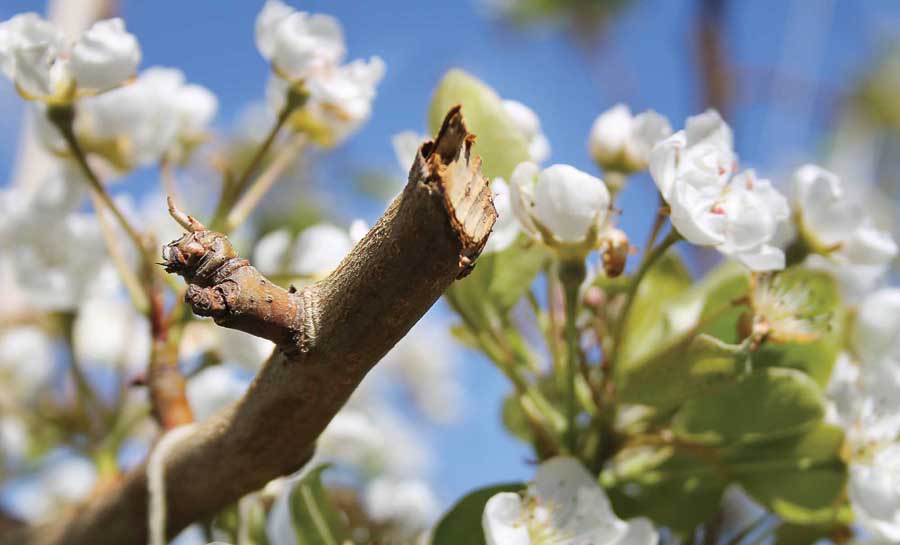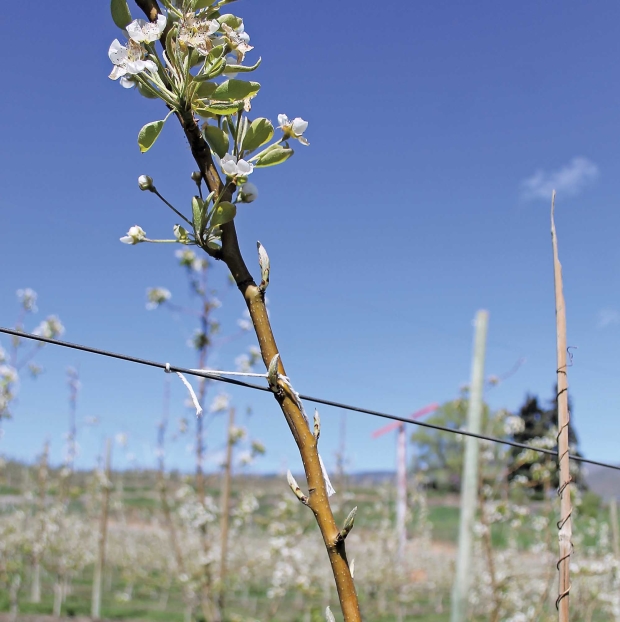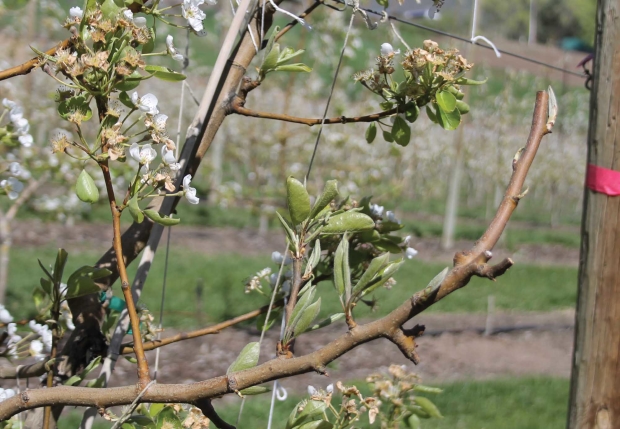Italian horticulturist Dr. Stefano Musacchi is introducing his concept of “dynamic pruning” to Bartlett pear growers in Washington’s Wenatchee Valley.
Related Story
Dynamic pruning involves rotating branches to minimize the aging of the bearing wood and maintain production of high fruit quality.
Branches are pruned on a three-year cycle so that new branches are constantly being produced in the tree. In year one, a branch is removed, leaving a stub. In year two, a replacement branch grows from the stub. In year three, spurs on the new branch will produce fruit. Branches need to be maintained in their space and not overlap.
Some growers never remove branches unless they are too big, Musacchi said, but unpruned branches tend to become old and not very productive.

Mechanical pruning can have the same effect as detailed pruning by hand, though the cuts are not selective. Buds develop in previously blind wood. (Geraldine Warner/Good Fruit Grower)

Cutting off the ends of the shoots turns blank wood into productive wood. In a fruiting wall system, upper branches should be about 10 inches long.(Geraldine Warner/Good Fruit Grower)

Branching on the axis can be stimulated by cutting the top off, to remove its apical dominance, or by pruning or girdling lower down. (Geraldine Warner/Good Fruit Grower)

Stefano Musacchi points out a “tira savia” cut that removed the branch’s apical dominance, resulting in buds that will produce fruiting spurs closer to the trunk. (Geraldine Warner/Good Fruit Grower)

After the terminal bud of the branch was removed, buds begin to develop closer to the leader, where there was blind wood.
(Geraldine Warner/Good Fruit Grower)

Pear branches should never be bent below horizontal. A 45- to 60-degree angle keeps limbs productive. (Geraldine Warner/Good Fruit Grower)
“If you don’t have other branches ready to replace them, we’ll be in trouble,” said Musacchi, who is now a research pomologist with Washington State University in Wenatchee. “Fruit quality will decrease in the future for sure. We have to make some renewal and try to correct the branches that are too drooping. The idea of dynamic pruning is nicer because you are always trying to renovate the wood.”
A spindle tree has a conical shape, with strong basal branches and smaller, weaker branches in the tops.
Branches can be bent to flatten the branch angle and promote fruiting, as is commonly done on apples, but a pear tree’s branches should never be bent below horizontal because they will develop blind wood towards the trunk and produce suckers from the top of the bend, and the vigor and fruit will be at the ends of the branches.
“If you want to keep the vigor in the top part of the trees, use a 45-degree angle,” he recommended.
To prevent blind wood, which is a common problem in Bartlett, he recommends what he calls short pruning, which involves cutting off one-year-old wood at the end of two- to three-year-old branches.
This will remove the apical dominance of the shoot, forcing buds to break lower down the branch. Musacchi’s objective is to keep the fruiting zone close to the trunk, where buds will be bigger and produce larger pears. Pears need more vigor to produce quality fruit, whereas apples can produce good fruit on weak wood.
To overcome blind wood on the axis, Musacchi recommends cutting the top off to remove the apical dominance and encourage branching.
Girdling or notching of the leader can also be done, using a clipper or small saw, to promote bud break below the wound.
Girdling can be done at green tip and can be combined with four or five weekly applications of Promalin (gibberellic acid and 6-benzyladenine) to keep the shoots active and growing.
Any shoots that compete with the top of the leader or are 30 percent of its diameter should be removed to a stub because they can create shade in the tree. Musacchi recommends only one big cut per tree per year to avoid losing too much crop at a time.
Dynamic pruning is very detailed but can be partially done using a lopper machine to reduce labor costs. However, unless the orchard is prepared for mechanical pruning, with the branches tied down and ready to be cut, it could be a waste of time, he warned. “Each different situation has to be managed in a different way.”
Mechanical pruning has a similar effect in shortening the branches, removing their apical dominance, and moving the fruiting zone closer to the trunk. However, because it is not selective and can’t cut branches oriented vertically or facing down the row, follow up pruning is needed by hand. Musacchi said mechanical pruning only needs to be done every two to three years. •
Video
Dr. Stefano Musacchi demonstrates his dynamic pruning concept in detail in a Washington State University video “Pruning Bartlett Pear to Optimize Fruit Quality.”





[…] (en anglais) axée sur le renouvellement des branches fruitières (aussi mentionné dans la revue Good Fruit Growers de septembre 2015) : […]
We love our readers…in any language!